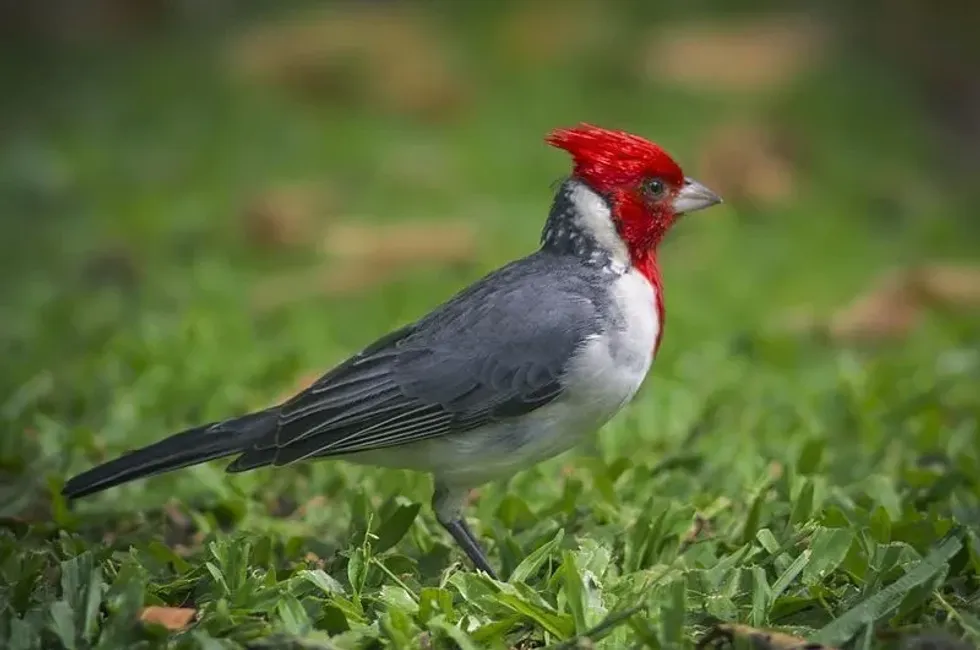The red-crested cardinal (Paroaria coronata) is a species of songbird in the tanager family (Thraupidae). Despite its similar name, the red-crested cardinal bird is not connected to the actual cardinal family (Cardinalidae).
Female red-crested cardinals are much smaller than male red-crested cardinal though they have a similar appearance. The popular name for the red-crested cardinal (Paroaria coronata) comes from its unique red head crest. The pet trade sector introduced these birds to Lima and from there, red-crested cardinal birds spread to other nations as well.
They are also known as Brazilian cardinals. Here are some interesting facts on the red-crested cardinal for your perusal. Afterwards, do have a look at our other articles on lyrebird facts and stork facts as well.
Red-Crested Cardinal Interesting Facts
What type of animal is a red-crested cardinal?
Red-crested cardinals are passerine birds found in North and South America that belong to the Thraupidae family, genus Paroaria, class Aves. The red-crested cardinal bird is also known as the Brazilian cardinal as the species was first found in Brazil.
What class of animal does a red-crested cardinal belong to?
Red-crested cardinal (P. coronata) bird belongs to the Aves class of animals like the red-cowled cardinal. Red-crested cardinals belong to the order Passeriformes, family Thraupidae, and genus Paroaria.
How many red-crested cardinals are there in the world?
According to the IUCN, the population of red-crested cardinal birds is of no concern at present because of its large range and stable population levels, hence no conservation efforts are warranted as of now. There is no accurate estimation of the total population of red-crested cardinals across their native habitat of Argentina, Brazil, Puerto Rico, Uruguay, Paraguay, and Bolivia.
Where does a red-crested cardinal live?
Red-crested cardinals live in semi-open environments with trees and shrubs, such as tropical shrubland, lawns, and degraded woods.
What is a red-crested cardinal's habitat?
The red-crested cardinal species may be found in South America's midsection, including Argentina, Brazil, Uruguay, Paraguay, Puerto Rico, and Brazil. In the wild, red-crested cardinals prefer semi-open habitats with scattered trees and vegetation, particularly near water.
Who do red-crested cardinals live with?
These brightly-colored Brazilian cardinal birds are diurnal and are generally observed in small groups or pairs. Outside of the mating season, these birds form bigger flocks.
How long does a red-crested cardinal live?
The average lifetime of a Brazilian cardinal is roughly about three to four years in the wild.
How do they reproduce?
The mating season for red-crested cardinals occurs between October and November each year. After mating, the pair will work together to create a nest of tiny organic materials like pine needles, sticks, and flexible twigs.
The nest will be finished with hemp string cut into 2 in (5 cm) length and unraveled and distributed around the flight. During the mating season, a female cardinal produces two to five eggs, which hatch after 12-13 days. After hatching, red-crested cardinal juveniles leave the nest in two to three weeks.
What is their conservation status?
Red-crested cardinals are classed as Least Concern in terms of conservation efforts required for their stable population and large range. The poaching of birds is a considerably greater issue, although it is yet to have a substantial impact on the population of the Brazilian cardinal.
Red-Crested Cardinal Fun Facts
What do red-crested cardinals look like?
The bright red head crest and upper breast are the standout features in the personality of these birds. Adult birds feature a dark-colored bill along with dark-colored legs.
While the younger birds are identical in appearance to adults, the red feathers are not present. Instead of the red head crest and upper breast, this species from the family Thraupidae have a brown head crest while the bill is of a dark color.
How cute are they?
The magnificent distinct colors on the feathers and body along with the bright red head crest, make these birds from the genus species Paroaria look more adorable.
How do they communicate?
Northern cardinals communicate largely through vocalizations and physical displays. Cardinals, both male and female, are known for their song. Their songs are a cacophony of lovely whistled words.
How big is a red-crested cardinal?
Red-crested cardinals belong to genus species Paroaria and may reach a length of 7.5 in (19 cm) and have a wingspan range of 10–12 in (25–31 cm).
How fast can a red-crested cardinal fly?
The red-crested cardinal can travel within a speed range of 20-30 mph (32-48 kph).
How much does a red-crested cardinal weigh?
A red-crested cardinal weighs around 1.55 oz (44 g).
What are the male and female names of the species?
There is no specific name for a male and female red-crested cardinal species. They are known as male red-crested cardinal and female red-crested cardinal. Both males and females are collectively also known as the Brazilian cardinal.
What would you call a baby red-crested cardinal?
There is no specific name for a baby red-crested cardinal. However, they are simply known as young red-crested cardinals.
What do they eat?
Birds of this species from the family Thraupidae mostly consume plant seeds, fruits, berries, and insects. It flies in an undulating pattern.
Are they dangerous?
When protecting their area, males may be hostile, and they regularly attack other males that invade. They can be aggressive. This proclivity causes cardinals to fly into glass windows when this species may charge an intruding bird, which is in fact their own reflection.
Would they make a good pet?
No, because it is prohibited to pet this species in the United States, you may be surprised to discover that it is a popular aviary bird in Europe.
Did you know...
Pedro, a red-crested cardinal, appears as a minor character in the films 'Rio' and 'Rio 2'.
Even though the male constructs the nest, his mate provides the ultimate approval.
Spiritually sensitive people often interpret a red cardinal sighting as a message from the holy spirit and that it will bring joy and happiness for them.
The symbolic meaning of cardinals is love and long-lasting relationships in the Native American culture.
Despite its similar name, the red-crested cardinal bird is not connected to the actual cardinal bird family (Cardinalidae) with predators such as bald eagles, hawks, owls, golden eagles, shrikes, and falcons.
Are there red cardinals in Hawaii?
Around 1930, red-crested cardinals were introduced to the Hawaiian Islands. Northern cardinals with a red crest are currently prevalent across the state of Hawaii. They are around 7.5 in (19 cm) long and have a unique red crest on the head. These birds prefer habitats such as parks, lawns, and dry thickets in Hawaii.
Is there a red white and blue cardinal?
Yes, there are 14 types of red, white and blue cardinal. Some of them are Spiza, Passerina, Periporphyrus, Habia, Cardinalis, and more.
Here at Kidadl, we have carefully created lots of interesting family-friendly animal facts for everyone to discover! For more relatable content, check out these dove facts and Anna's hummingbird facts pages.
You can even occupy yourself at home by coloring in one of our red cardinal with holly coloring pages.










